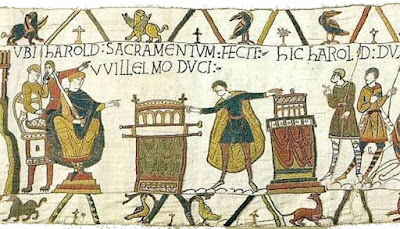[11] HIC VVILLELM[US] DEDIT HAROLDO ARMA
Hīc ¦ Willelmus
¦ dedit ¦ Haroldō arma
Here ¦ William
¦ gave ¦ arms to Harold
[12] / [13] HIE*
VVILLELM[US] VENIT BAGIAS / VBI HAROLD SACRAMENTVM FECIT VVILLELMO DUCI
*Hie: an odd
mistake given that it had been sewn so many times before! The tapestry was
certainly created by a group of needleworkers. It should be hīc (here).
Hīc ¦ Willelmus ¦ vēnit ¦ Bagias /
Ubi ¦ Harold sacrāmentum fēcit ¦ Willelmō dūcī
Here ¦ William ¦
came ¦ to Bayeux / Where Harold made an oath
¦ to Duke William
There is some
discussion as to the use of Bagias for Bayeux; that the text
is saying ‘to Bayeux’ would suggest it is an accusative (used
without prepositions to indicate ‘to’ a named town / city e.g. Rōmam │ to Rome).
That would make the name Bagiae ( > Bagiās: to Bayeux).
Some notes on it here (p126, p135), a lengthy book but very detailed:
https://ia801609.us.archive.org/7/items/bayeuxtapestry00fowk/bayeuxtapestry00fowk.pdf
Also:
https://en.wikipedia.org/wiki/Bayeux
Both links discuss
the origin of the name.
[14] They know
their deponent verbs …
HIC HAROLD DVX
REVERSVS EST AD ANGLICAM TERRAM
Hīc Harold
dux reversus est ad Anglicam terram
Here Duke
Harold has returned to English territory
revertor,
revertī, reversus sum: return
[15] … and the
passive verbs …
HIC PORTATVR
CORPVS EADWARDI REGIS AD ECCLESIAM S[AN]C[T]I PETRI AP[OSTO]LI
Hīc portātur corpus
Eadwardī rēgis ad ecclēsiam Sānctī Petrī Apostolī
Here the body of
King Edward is being carried to the church of St. Peter the
Apostle
[16] / [17] HIC
EADVVARDVS REX IN LECTO ALLOQVIT[UR] FIDELES / ET HIC DEFVNCTVS EST
Hīc Eadwardus rēx
in lectō alloquitur fidēlēs / Et hīc dēfūnctus est
Here Edward in
bed speaks to / addresses his faithful
(followers) / And here he has died
alloquor
(adloquor), alloquī, allocutus sum [3/deponent]: address
dēfungor,
dēfungī, dēfunctus sum [3/deponent]: (here) die
Interesting to
note the different ways in which the name Edward is sewn,
suggesting different needleworkers: [15] CORPVS EADWARDI (Vs
intertwined) [16] HIC EDVVARDVS (VV); the early beginnings of the
separate W
[18] ISTI
MIRANT[UR] STELLA[M]
Istī ¦ mīrantur ¦ stēllam
These (people / men)¦ marvel at ¦
the star
In Classical
Latin iste, ista, istud (that [one /
man / woman]; pl: those [people]) was often used negatively. However, that
pejorative sense was gradually lost and it was used no differently from the
other demonstratives ille and hic. Latin iste =
Spanish este (this).
mīror, mīrārī,
mīrātus sum [1/deponent]: wonder / marvel at; admire
The ‘star’ being
referred to is generally identified as Halley’s Comet:
https://www.nasa.gov/history/955-years-ago-halleys-comet-and-the-battle-of-hastings/
[19] HIC
WILLELM[US] DVX IVSSIT NAVES [A]EDIFICARE
Hīc ¦ Willelmus
dux ¦ iussit ¦ nāvēs aedificāre
Here ¦ Duke
William ¦ has given the order ¦ to build
ships
iubeō, -ēre, iussī
[2]: order; command
Note the writing
of the Latin diphthong /ae/ as /e/ i.e. aedificare > edificare;
this is reflecting a pronunciation change evident in the Mediaeval manuscripts
where /ae/ is commonly written as /e/








No comments:
Post a Comment